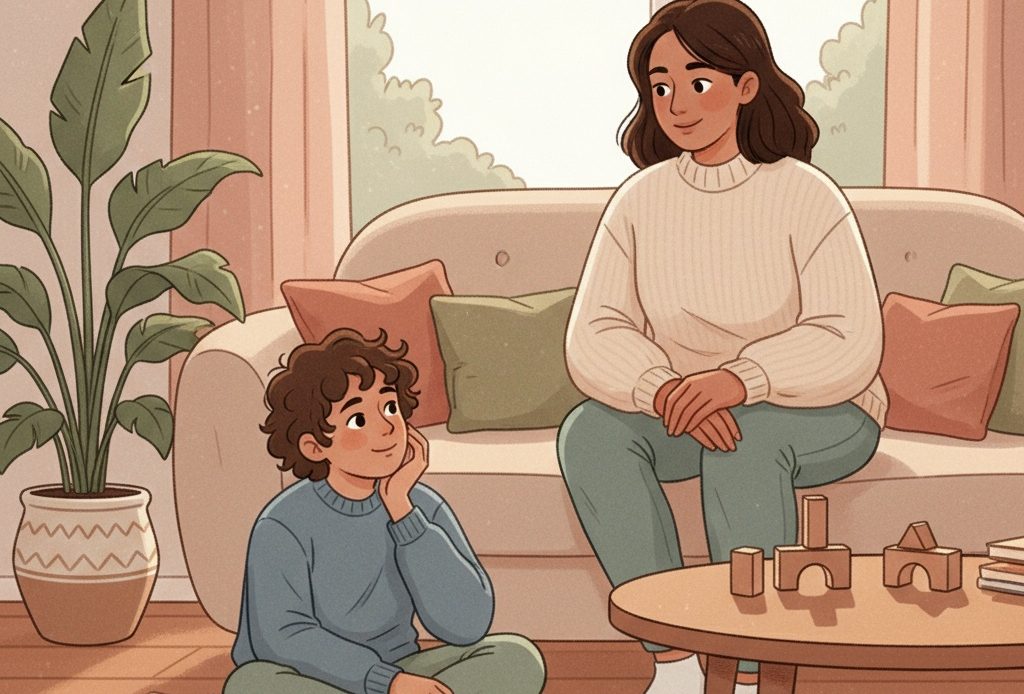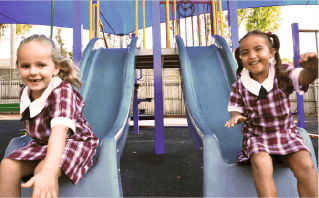
You notice your capable, intelligent child suddenly refusing to try out for the soccer team they were excited about last month. Or melting down over homework that should be straightforward for their ability level. Or asking endless “what if” questions that spiral into tears no matter how many times you reassure them.
As a psychologist with over 20 years of experience working with anxious children, I see these patterns daily in my practice. More importantly, as a mother, I’ve lived them. I’ve been the parent awake at 2am with a child whose brilliant mind is trapped by worry, feeling heartbroken and helpless.
Here’s what I’ve learned: anxiety in children ages 8-12 looks dramatically different than adult anxiety. Many parents miss the signs because they’re expecting obvious worry or panic attacks. Instead, anxiety in this age group often disguises itself as behaviour problems, physical complaints, or what looks like laziness or defiance.
If you’re reading this because something feels off with your child but you can’t quite name it, trust that instinct. Here are the 10 signs I watch for in my practice when assessing anxiety in children ages 8-12.
1. Perfectionism That Paralyses
Your 10-year-old spends three hours on homework that should take 30 minutes, erasing and rewriting until the paper tears. Or they refuse to start a school project because they “don’t know how to make it perfect.” Or they have a complete meltdown when they score 9 out of 10 on a spelling test, convinced they’re a failure.
This isn’t about having high standards. This is anxiety wearing the mask of perfectionism.
When children feel anxious about their worth or competence, they develop an unconscious belief: if I’m perfect, I’ll be safe from criticism, failure, or rejection. Perfectionism becomes a control strategy, a way to manage the underlying fear that they’re not good enough.
The key distinction is this: healthy striving feels energizing and motivating. Anxious perfectionism feels paralyzing and distressing. If your child is avoiding tasks because they might not do them perfectly, or if mistakes trigger intense emotional reactions, you’re likely seeing anxiety, not ambition.
In my practice, I’ve watched perfectionist children miss out on friendships, extracurricular activities, and learning opportunities because the fear of imperfection keeps them frozen. The tragedy is that these are often the most capable children, the ones with the most potential, held back by an impossible standard they’ve set for themselves.
2. Physical Complaints Without Medical Cause
Stomachaches every school morning that mysteriously disappear on weekends. Headaches before tests. Feeling “sick” before social events. Complaints of dizziness, nausea, or chest tightness that medical evaluations can’t explain.
As a psychologist, I always recommend parents rule out medical causes first. But once you’ve done that and doctors find nothing wrong, it’s time to consider anxiety.
Here’s what’s happening: anxiety doesn’t just live in the mind. It lives in the body. When children feel anxious, their nervous system activates the stress response. Blood flow redirects away from the digestive system, causing genuine stomach discomfort. Muscles tense, causing real headaches. The heart rate increases, creating sensations of chest tightness or difficulty breathing.
For children ages 8-12, these physical sensations are often easier to identify and communicate than the emotional experience of anxiety. A child might not be able to say “I feel anxious about the math test,” but they can say “my stomach hurts.”
The pattern to watch for: physical complaints that consistently appear before anxiety-provoking situations and resolve once the situation is avoided or completed. If your child’s stomachache disappears the moment you agree they can stay home from school, anxiety is likely the culprit.
3. Avoidance of Age-Appropriate Activities
Your previously social child suddenly refuses birthday party invitations. They won’t try out for the team even though they love the sport. They avoid sleepovers, school camps, or any situation where they might be away from you. They make excuses to skip activities they used to enjoy.
Avoidance is anxiety’s favorite strategy. When something feels threatening, the instinct is to avoid it. And here’s the cruel trick: avoidance works in the short term. Your child feels immediate relief when they don’t have to face the feared situation.
But avoidance makes anxiety stronger over time. Each time a child avoids something, their brain learns: “That situation is dangerous. Good thing we avoided it.” The anxiety grows, and the list of avoided situations gets longer.
I’ve worked with 11-year-olds who started by avoiding one friend’s birthday party and ended up avoiding all social situations. I’ve seen 9-year-olds who began by skipping one soccer practice and eventually quit activities entirely.
The key question isn’t “Does my child avoid things?” Most children avoid things sometimes. The key question is: “Is avoidance expanding? Is my child’s world getting smaller?” If your capable child is pulling back from age-appropriate challenges and opportunities, anxiety is likely driving that retreat.
4. Excessive Reassurance Seeking
“Will I be okay?” “Are you sure?” “But what if something bad happens?” “Promise nothing will go wrong?”
Asked once, these are normal childhood questions. Asked twenty times in an hour, despite your patient reassurance, they’re signs of anxiety.
Anxious children develop an insatiable need for reassurance. They’re trying to borrow your certainty because they can’t find it within themselves. The problem is that reassurance provides only temporary relief. Within minutes, the anxiety returns, and they need to ask again.
This creates an exhausting cycle for parents. You reassure your child that yes, you’ll pick them up from school. Yes, you promise. Yes, you’re absolutely sure. And five minutes later, they ask again. It feels like they’re not listening, but that’s not what’s happening. Anxiety is so loud that your reassurance can’t compete.
In my practice, I teach parents to recognize when reassurance-seeking has become compulsive. One or two questions deserve patient answers. But when the same question repeats endlessly, it’s time to gently acknowledge the anxiety rather than feed the reassurance cycle: “I hear that you’re feeling worried. I’ve already answered that question, and my answer hasn’t changed. Let’s practice managing the worried feeling together.”
5. Irritability and Emotional Outbursts
This surprises many parents: anxiety doesn’t always look like a worried, timid child. Often, it looks like an angry, explosive one.
Your 9-year-old has a meltdown because their shoelace won’t tie correctly. Your 11-year-old snaps at you over minor requests. Your typically sweet child seems constantly on edge, irritable, quick to anger over small frustrations.
Here’s what’s happening beneath the surface: anxiety activates the fight-flight-freeze response. While some children respond with flight (avoidance) or freeze (shutdown), others respond with fight (anger and aggression).
Think about how you feel when you’re stressed and anxious. You’re probably more irritable, less patient, quicker to snap. Children experience the same thing, but they have less capacity to recognize and manage it.
The child who seems angry about homework might actually be anxious about their ability to complete it. The child who explodes when plans change might be anxious about unpredictability. The child who lashes out at siblings might be carrying anxiety from school that has nowhere else to go.
In my two decades of practice, I’ve seen countless children misdiagnosed with behaviour problems when anxiety was the root cause. Once we addressed the underlying anxiety, the “behaviour issues” resolved.
6. Sleep Difficulties
Bedtime becomes a battle. Your child can’t fall asleep because their mind is racing with worries. They wake up multiple times during the night. They have nightmares. They need you present to fall asleep, even though they’re old enough to sleep independently.
Sleep and anxiety have a bidirectional relationship: anxiety disrupts sleep, and poor sleep worsens anxiety. It’s a vicious cycle that leaves both children and parents exhausted.
For anxious children ages 8-12, bedtime is when the distractions of the day disappear and worries rush in. Without school, friends, or activities to occupy their minds, anxiety takes center stage. Worries that were manageable during the day become overwhelming in the quiet darkness.
Common sleep-related anxiety patterns I see include: difficulty falling asleep due to racing thoughts, waking during the night with worries, nightmares about feared situations, fear of sleeping alone, and needing elaborate bedtime routines that must be followed exactly or anxiety spikes.
As a mother of anxious children, I know the exhaustion of bedtime battles. As a psychologist, I know that sleep difficulties are often the first sign parents notice when anxiety is developing. If your child’s sleep has changed, pay attention.
7. Rigid Thinking and Need for Control
Everything must happen a certain way, or your child melts down. Morning routines must follow an exact sequence. Dinner must be specific foods arranged in a particular way. Plans cannot change, even slightly, without triggering intense distress.
This looks like inflexibility or difficult behavior, but it’s actually an anxiety management strategy.
When the world feels unpredictable and threatening, control provides a sense of safety. If your child can control their environment, their routine, their food, they feel less anxious. The problem is that life is inherently unpredictable, and the more rigidly they try to control things, the more distressed they become when inevitably, something doesn’t go according to plan.
I’ve worked with 8-year-olds who have complete meltdowns when we take a different route to school. I’ve seen 12-year-olds unable to enjoy family vacations because the unpredictability triggers overwhelming anxiety.
The key distinction: all children have preferences and routines they enjoy. Anxious children have rigid requirements that cause significant distress when not met. If your child’s need for sameness is interfering with daily life and their ability to be flexible, anxiety is likely underneath.
8. Social Withdrawal
Your previously social child now avoids friends. They eat lunch alone at school. They don’t want to join group activities. They seem isolated and lonely, but they refuse opportunities for social connection.
Social anxiety often emerges or intensifies during the 8-12 age range. This is when peer relationships become more complex, social hierarchies form, and children become acutely aware of how they’re perceived by others.
Anxious children worry: “What if I say something stupid? What if they don’t like me? What if I’m left out? What if I embarrass myself?” These worries become so overwhelming that avoiding social situations feels safer than risking social failure.
It’s important to distinguish between introversion and anxiety-driven isolation. Introverted children enjoy social connection in smaller doses and need alone time to recharge, but they don’t avoid social situations out of fear. Anxious children want connection but are too afraid to pursue it.
In my practice, I’ve watched social anxiety steal friendships and opportunities from children who desperately want to connect but don’t know how to manage the fear. The loneliness compounds the anxiety, creating a painful cycle.
9. Academic Changes
Grades are dropping despite your child’s capability. Or conversely, your child is obsessively focused on grades, studying for hours, unable to tolerate anything less than perfection. They avoid challenging classes. They won’t participate in class discussions. Test anxiety is so severe they can’t demonstrate what they know.
Academic anxiety can manifest in two opposite ways, and I see both regularly in my practice.
Some anxious children become so overwhelmed by academic pressure that their performance declines. They avoid homework, procrastinate on projects, or rush through work carelessly because the anxiety of doing it perfectly is too overwhelming. Teachers might describe them as “not working to potential” or “capable but unmotivated.” But it’s not a motivation problem. It’s an anxiety problem.
Other anxious children become obsessively focused on achievement. They study excessively, redo work compulsively, and experience intense distress over minor grade fluctuations. They might be getting straight A’s, but at what cost? These children are often praised for their work ethic, but underneath, they’re struggling with crippling anxiety.
Both patterns deserve attention. Academic struggles or academic obsession can both signal anxiety that needs support.
10. Excessive Worry About Future Events
Your child worries about the test that’s three weeks away. They’re anxious about the school camp that’s not until next term. They catastrophize about situations that might never happen: “What if there’s a fire drill and I’m in the bathroom? What if I forget my lines in the school play? What if my teacher gets sick and we have a substitute?”
This is called anticipatory anxiety, and it’s exhausting for both children and parents.
While some worry about upcoming events is normal, anxious children get stuck in worry loops. They imagine worst-case scenarios, play them over and over in their minds, and can’t shift their attention to the present moment. The future feels threatening, and they’re trying to prepare for every possible negative outcome.
I’ve worked with 10-year-olds who couldn’t enjoy their current day because they were worried about something happening next month. The anxiety steals their ability to be present, to enjoy childhood, to feel safe in the moment.
The pattern to watch for: worry that’s disproportionate to the situation, starts far in advance, and doesn’t resolve with reassurance or problem-solving. If your child is chronically worried about the future, anxiety has taken up residence in their mind.
What Makes Anxiety Different from Normal Childhood Worries
At this point, you might be thinking: “But isn’t some worry normal? Don’t all children experience some of these things sometimes?”
Absolutely. Every child worries occasionally. Every child avoids things sometimes. Every child has bad days.
Here’s how to distinguish normal childhood worries from anxiety that needs support:
Frequency: Normal worries come and go. Anxiety is persistent, showing up day after day, week after week.
Intensity: Normal worries are manageable with reassurance or distraction. Anxiety is intense, overwhelming, and difficult to soothe.
Interference: Normal worries don’t significantly interfere with daily life. Anxiety prevents children from doing things they want or need to do—it shrinks their world.
Physical symptoms: Normal worries might cause butterflies in the stomach. Anxiety causes persistent physical symptoms that feel genuinely distressing.
Duration: Normal worries resolve relatively quickly. Anxiety persists even after the feared situation passes or is avoided.
If you’re recognizing multiple signs from this list, and they’re frequent, intense, and interfering with your child’s daily life, it’s time to take action.
What To Do If You Recognize These Signs
First, take a breath. Recognizing anxiety in your child doesn’t mean you’ve failed as a parent. It means you’re paying attention, and that awareness is the first step toward helping them.
Here are your next steps:
Validate their feelings: Let your child know that anxiety is real, it’s not their fault, and it’s something you can work on together. Avoid dismissing their worries with “there’s nothing to worry about” or “just stop thinking about it.” Anxiety doesn’t work that way.
Avoid accommodating avoidance: While it’s tempting to let your child skip the anxiety-provoking situation to provide immediate relief, avoidance makes anxiety stronger over time. Instead, provide support while gently encouraging them to face manageable challenges.
Create calm-down routines: Teach your child practical strategies for managing anxious moments: deep breathing, progressive muscle relaxation, naming emotions, grounding techniques. Practice these when they’re calm so they’re available when anxiety strikes.
Consider professional assessment: If anxiety is significantly interfering with your child’s daily life, school performance, friendships, or family functioning, consult with a psychologist who specializes in childhood anxiety. Evidence-based treatments like Cognitive Behavioral Therapy are highly effective for anxious children.
Provide structure and tools: Anxious children benefit from consistent, structured approaches to managing their anxiety. This is where resources like anxiety journals and workbooks can be invaluable.
If you’re recognizing multiple signs in your child and feeling heartbroken watching their potential held back by anxiety, our award-winning Unleash Anxiety Journal provides the daily structure and evidence-based tools to help them build confidence and emotional regulation skills. Developed by a psychologist specifically for ages 8-12, it guides children step-by-step to create their own anxiety management plan, using the same techniques I teach in my practice.
The journal uses Cognitive Behavioral Therapy techniques, mindfulness practices, and social-emotional learning strategies in a child-friendly format that encourages creativity and personalization. Children complete anxiety scales before and after working through the journal, and those who finish consistently report reduced anxiety symptoms.
Most importantly, it gives children something many anxious kids desperately need: a sense of control and competence in managing their own emotional experiences.
You’re Not Alone
Anxiety is one of the most common mental health challenges affecting children today. If you’re reading this and recognizing your child in these descriptions, please know: you’re not alone, your child is not broken, and anxiety is highly treatable.
As both a psychologist and a mother who has navigated childhood anxiety in my own family, I can tell you this: with the right support, tools, and understanding, anxious children can learn to manage their anxiety and thrive. They can reclaim the opportunities anxiety has stolen. They can build confidence, resilience, and emotional intelligence that serves them for life.
The fact that you’re here, reading this, seeking to understand what your child is experiencing—that’s exactly the kind of engaged, caring parenting that makes all the difference. Trust yourself, trust the process, and know that help is available.
Your capable, wonderful child is still in there. Anxiety is just temporarily blocking their light. With your support and the right tools, they can shine again.
Related Articles
7 Emotional Regulation Techniques for Anxious Kids
Beyond the Bubble: Rethinking Overprotective Parenting
What is the antidote to anxiety?
Understanding and Addressing School Refusal: A Parent’s Guide
References




